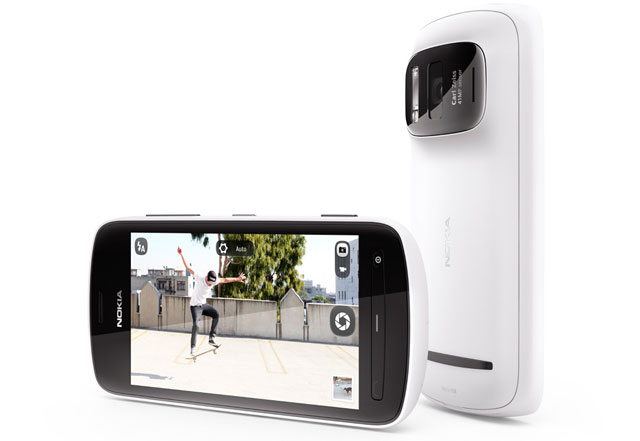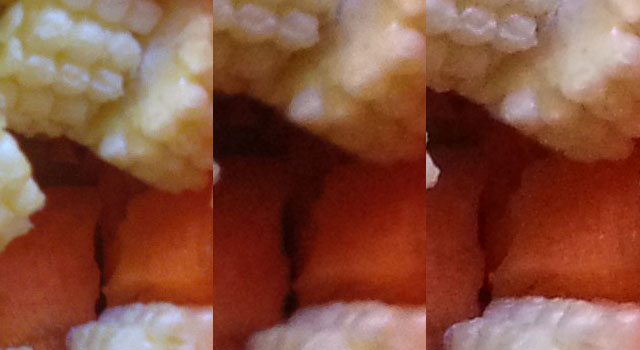
Finnish handset manufacturer Nokia pioneered cameras in mobile phones. Now it’s looking to set the standard again with the 41-megapixel shooter in its Pureview 808 handset. The phone boasts the highest resolution camera ever seen in a handset, but is that enough reason to consider the device, particularly given some of Nokia’s other peculiar decisions when it comes to its design?
One of the strangest things about the Pureview is the choice of operating system (OS). Rather than using Windows Phone, which powers Nokia’s flagship Lumia range, the company has opted for the dated Symbian OS — version 10.1 “Belle” in this instance. Symbian is a clumsy, sluggish and dated solution when compared to Windows Phone.
Nokia will surely rectify this with later models in the Pureview range, but it seems bizarre that the 808 has been saddled with what feels like outdated software, and all the more so because it’s a device that’s otherwise intended to be at the cutting edge.
Another anomaly is the fact that Nokia calls it a 41-megapixel camera when it is, in fact, effectively a 38-megapixel camera (multiply the width and height of an image together and you get 38,4m).
There’s a price to pay for squeezing a 38-megapixel camera into a pocket-sized device. The first of these is that the Pureview is 13,9mm thick and built like Dolly Parton. It’s decidedly top heavy, but surprisingly comfortable to hold. The matt, slightly textured finish helps in this regard, and makes it feel like a high-end device.
At just under 170g, the Pureview 808 isn’t actually that much heavier than other top-end smartphones. It just feels hefty on account of how thick it is and the fact that the camera housing protrudes so noticeably.
At full tilt, the camera produces images of with a resolution of 7 152×5 368 pixels. Needless to say, that’s enormous.
Why bother with such a large sensor? Partly so that you can turn digital zoom into a vaguely useful feature. With mobile phones being too slim to handle optic zoom lenses, and no one wanting a lens that protrudes from their phone, more megapixels means you can take 5- or 8-megapixel “zoomed” images by using only a portion of the available pixels.


This is an innovative idea from Nokia and one that will no doubt show up in other manufacturers’ devices soon enough, hopefully in a slimmer and otherwise better-equipped body.
By default, the 808 doesn’t actually shoot at full resolution. Rather, it shoots 5-megapixel images and allows users to zoom (it’s impossible to zoom if shooting at full resolution). That’s also because no one in their right mind actually wants to send an image that can be as big as 7MB using their mobile phone.
Supposedly, this also means better-quality pictures overall because the handset starts with a higher resolution image (assuming one hasn’t zoomed in) and compresses it to 5-megapixels.

The camera menu is intuitively laid out and allows for a great deal of control. Three custom modes allow you to fiddle ISO, exposure compensation, colour rendition and even shoot bracketed shots for creating HDR (high-dynamic range) images.
There’s a dedicated two-step camera button on the right-hand side of the 808 that can be used to enter camera mode from the lock screen, and the unlock slider can be used to toggle the flash on and off for use as a torch by holding it for an extended period. There’s little discernible shutter lag when taking a picture, but there can be a delay while it saves, particularly if shooting at full resolution.
One would expect the images from the Pureview 808 to be excellent, but in our experience they simply aren’t. On the whole, colour reproduction is natural and it certainly handles low-light images far better than the competition, but the compression can make for softer shots overall and the lack of saturation — while perhaps more natural — results in duller images than those from either the iPhone 4S or the Samsung Galaxy S3.
In theory the Pureview should blow the competition out of the water, and in terms of resolution it does. But in day-to-day use it’s no better, and in some instances arguably worse, than other leading mobile phone cameras. Unless you deliberately create a custom setting to shoot images at the full 38-megapixel resolution images come out at 5-megapixels, and this is three less than either the Samsung or the iPhone 4S. Most users want to point and shoot, and other current handsets simply do this better.

The Xenon flash performs well in low light and is accompanied by an LED light for shooting video. The 808 captures video at 1 080p at 30 frames a second, and the front-facing camera is capable of the same frame rate, albeit at VGA (640×480-pixel) quality.
Like most of its competitors, the 808 allows you to tap on the image to select the focus point and, because of its f2,4 maximum aperture and the fact that it’s sensor is roughly the size of a postage stamp — about four times the size of most camera phone sensors — it’s possible to isolate subjects from the background with ease.
With a 1,3GHz processor and 500MB RAM, the 808 soon slows down when asked to run multiple applications and, on the whole, the experience is by no means the most fluid we’ve encountered. Home screen widgets can take a moment or two to refresh and the experience is reminiscent of a far older handset when it comes to day-to-day operations.
Aside from the interface, another letdown is the 4-inch Amoled screen. Colour rendition and viewing angles are excellent, but with a resolution of only 360×640 pixels, one can’t help feeling a little disappointed, particularly in light of the enormous and detailed images the device is capable of capturing.
The 808 supports micro-Sim cards and has an expansion slot for a microSD card, up to a maximum of 32GB. It comes with 16GB of onboard storage and includes an HDMI port and a 3,5mm audio jack.
In many ways, Symbian really is the most disappointing aspect of the 808. It’s not the worst mobile OS we’ve ever seen, but it looks so dated compared to the latest versions of Google’s Android and Apple’s iOS. There’s also a far slimmer selection of applications available and the knowledge that Symbian is on the way out makes it difficult to recommend. Buy an 808 and you’re investing in legacy software.
Symbian also has other quirks that can prove annoying. The menu structure isn’t the most intuitive and the result is a substandard user experience. Neither the impressive camera nor other touches like an FM transmitter can make up for a deficient experience. Unless, of course, you’re a Nokia loyalist or the sort of user for whom a mobile phone is primarily a photographic tool.
If you’re looking for a superb smartphone with a capable camera, you’re better off getting a rival handset, or one of Nokia’s own Lumia range. If you’re looking for a superb camera, an equally capable compact can be had for less money.
Ultimately, the 808 is exciting because of what it portends. There’s no compelling reason to pick one up now other than for its value as a conversation piece. It feels like an experiment rather than a genuine competitor in the current smartphone market.
The 808 is easily as well equipped as your average compact camera, but the problem is that it’s also a phone. It’s a great camera, but a decidedly mediocre phone. — (c) 2012 NewsCentral Media
- The Pureview 808 retails for R7 999 outside of a contract and is only available from Vodacom

